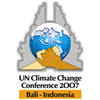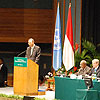As they have every dry season for the last 20 years, once lush tropical peatlands in Indonesia smoldered for weeks this year, leaving the region cloaked in a thick, carbon-rich haze.
The rainy season arrived at the end of October, squelching the flames. Even so, Jack Rieley, a peatland ecologist at the University of Nottingham in the United Kingdom, had no time to sigh in relief. With the rains come the floods."Another downside is the peatlands are losing their water-retention potential," he said. "Surrounding areas, especially those downstream, tend to flood quicker now."
The downsides, according to Rieley, result from the vast chunks of Indonesia's peatlands that have been burned, logged, drained, and left vulnerable to fire. It's all part of an effort to feed a burgeoning population of more than 210 million people and jump-start an ailing economy.
Tropical peatlands consist of layer upon layer of forest debris too wet to decompose. They cover approximately 50 million acres (20 million hectares) in Indonesia, or nearly 11 percent of the country's total land area. Key areas of peatland burning include Borneo, Sumatra, and West Papua.
Rieley is the co-leader of an international project that has studied the ecology of the peatland in the province of Central Kalimantan in Borneo since 1993.
Scientists know that these peatlands serve as gigantic stores of carbon. They have accumulated woody debris for millennia, locking it up in soggy piles that in places reach 66 feet (20 meters) deep.
Now that the peatlands regularly burn, Rieley and his colleagues say these carbon stores have become carbon sources. They're rapidly increasing atmospheric concentrations of the greenhouse gas carbon dioxide (CO2), potentially spurring global warming.
"I am a peatland expert, not a climate one," Rieley said. "What I do know, however, is that tropical peatlands are releasing a very large amount of carbon from [storage] that is likely to be contributing to the accelerating increase in CO2 in the atmosphere."
"If other experts believe that this higher level of CO2 is propelling global warming, then of course tropical peatlands are part of that," he added.
http://news.nationalgeographic.com/news/2004/11/1111_041111_indonesia_fires.html






No comments:
Post a Comment